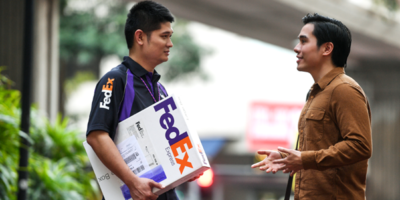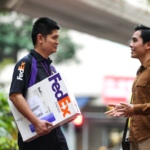
(Source – foodpanda)
Consumer to consumer logistics made simpler with pandago
The logistics industry has witnessed a huge uptake since the pandemic started. While there are concerns of an oversupply in the industry, the reality is, the demand for more logistic options is only increasing.
According to a report by McKinsey, the Asia e-commerce logistics market will account for 57% of total market growth from 2020 to 2025. Industry players will, therefore, need to reconfigure their networks if they aim to capture these opportunities, especially in catering to consumers (B2C). Moreover, figures do not include other business to business (B2B) logistic services, which despite supply chain disruptions, continue to grow as well.
In Singapore, apart from B2B and B2C logistics, consumers are also looking for a faster and seamless way to get their shipments going, especially for deliveries. Be it parcels, documents or even food, the consumer to consumer (C2c) deliveries industry in the Singapore has also seen a boom in recent times. While there are already several brands offering such services, to cater to this growing demand, foodpanda also launched its version of C2C deliveries business through pandago.
Initially, pandago was operating as a B2B to empower businesses with instant delivery. It was only recently that pandago has expanded its business model to C2C. pandago C2C deliveries is a type of order under pandago that enables foodpanda customers to send anything to anyone. As such, pandago now allows consumers to trade and exchange goods between one another, making it a convenient way for consumers to receive their products without the need to visit a physical store.
To understand more about pandago’s new C2C offerings, Tech Wire Asia speaks to Bhavani Mishra, Director of Logistics, foodpanda APAC. Mishra explains how C2C can be a game changer in the industry as well as how consumers can make the most out of it.
Will C2C express and pandago deliveries be game changers for both customers and businesses?

Bhavani Mishra, Director of Logistics, foodpanda APAC
In 2020, foodpanda launched a new logistics-as-a-service (LaaS) solution, pandago, targeted at businesses looking for a fuss-free on-demand delivery service. pandago allows any business to tap into foodpanda’s fleet of thousands of riders for small deliveries. Earlier this month, it introduced a new feature for customers in Singapore to deliver parcels.
Customers who want to send items to friends and family no longer need to go through traditional courier services which not only take longer to deliver but are often tedious or expensive to engage. Instead, with a touch of the button on the foodpanda app, they can have anything picked up from their doorstep and delivered in under 60 minutes, 24/7. Whether it’s sending a surprise birthday gift at midnight, or getting documents over urgently to another party, customers can quickly and easily order delivery through pandago. They can also track their deliveries with a real-time tracking function that provides updates on their delivery status and their delivery rider’s location.
This fuss-free and interconnected customer experience have also proven to be reliable and cost-efficient even for businesses, especially small and medium enterprises (SMEs) like home-based businesses, pop-up shops, or neighborhood mom-and-pop stores. It empowers SMEs to adopt a new hybrid business model with quick-commerce (q-commerce) and tap into new customer segments to scale their businesses. pandago allows such businesses, even if they are not listed as a foodpanda merchant, to provide easy doorstep deliveries that make it even more convenient for customers.
Should riders be concerned about pandago affecting their income?
Riders will in fact benefit from pandago, as it brings more earning opportunities. In addition to food and groceries, riders can also deliver parcels to boost their income. As pandago operates 24/7, riders have the opportunity to get compensated according to the distance they travel and earn an income even during off-peak hours.
In our ten years operating in Asia, we’ve always remained committed to ensuring a balanced ecosystem for our community of riders, merchants, partners, and customers. In addition to earning opportunities, riders also have the flexibility to decide if they want to accept an order or not. They can see how much they’re going to make on an order before accepting it. This has been designed with our riders’ comfort in mind, helping to ensure that their livelihood needs are met.

(Source – foodpanda)
Can you also share how the industry has been coping in the post-pandemic era, especially with more folks returning to work in office? Has there been a drop in demand?
While markets have started to open up, customers are still using foodpanda to order food, everyday essentials, and more. With lifestyles evolving over the past few years, we see sustained demand for on-demand deliveries as customers have become accustomed to ultra-fast deliveries. To better support this, we are committed to further investing and growing our q-commerce verticals.
At the same time, how is pandago helping businesses cope with overwhelming customer demand?
We launched pandago in late 2020 to help businesses grow and thrive amidst the pandemic. With no onboarding fee or commission fees, businesses can better manage their delivery costs by spending only when they need it. pandago can also serve as a flexible solution that can help boost a business’ existing fleet in the event of an order surge.
For instance, in Pakistan, we partnered with a local pharmacy to help deliver medicines and other pharmaceutical products via pandago. Similarly, in Taiwan we enabled the largest local supermarket chain, PX Mart, to offer on-demand deliveries for fresh and frozen foods and groceries. In Taiwan, we also collaborated with a local NGO to help deliver daily essentials to locals during the pandemic.
Delivery fees in Singapore start at a base fee of $6, with additional per-kilometer distance-based fees. With a cost-effective, pay-as-you-use fee structure, businesses can utilize pandago for their on-demand delivery needs, even if they are not foodpanda merchant partners – this greatly benefitted SMEs and home-based businesses. pandago can even deliver items like flowers, handmade crafts, and home-baked cookies to their customers.

(Source – foodpanda)
With more players in the industry now, how can retailers and F&B owners make the best of the delivery options available to them? And how is foodpanda [pandago] dealing with the competition?
foodpanda serves our merchant community regardless of their business models and provides solutions for all delivery needs. Companies that require logistics support can tap on pandago in various ways. For example, restaurant chains like Pizza Hut, Mcdonald’s, KFC, and Burger King use pandago as a supplementary delivery fleet. While they have their own delivery fleet, they still outsource to pandago as and when needed – such as during peak hours or after hours.
On the other hand, brands like Flash Coffee outsource all their deliveries to pandago. It helps Flash Coffee to focus its resources on its business while letting pandago take care of the end-to-end logistics. With its partnership with pandago, Flash Coffee is the first coffee player in Singapore to offer deliveries through its own app.
Any company can outsource deliveries to pandago without being a foodpanda merchant. These include grocery stores, minimarts, bakeries, florists, home-based businesses, and many more. They can simply create a pandago account within minutes and have anything delivered to their customers in 30 minutes. It’s easy to use, flexible, and even includes live tracking for each order.
Are there plans to expand C2C express to other markets in Asia?
We are always looking to innovate and strengthen our q-commerce offering. After the successful launch of C2C deliveries in Singapore, we look to expand this feature in other markets as well. We are excited for this next phase of growth of foodpanda and look forward to doing more for our customers.
Lastly, what are the key trends in Asia shaping the future of deliveries in this part of the world? Will autonomous deliveries be a prominent feature in the years to come?
Drones and other robotic technology add a new dimension to deliveries as it makes it easier for people in rural or remote areas to access food and other essentials. In Singapore, we piloted drone deliveries to offshore vessels and islands. Similarly, we also successfully piloted drone deliveries in Pakistan. foodpanda has always been exploring new innovations and will continue to look for new ways to better serve our customers and community in the future.
READ MORE
- Strategies for Democratizing GenAI
- The criticality of endpoint management in cybersecurity and operations
- Ethical AI: The renewed importance of safeguarding data and customer privacy in Generative AI applications
- How Japan balances AI-driven opportunities with cybersecurity needs
- Deploying SASE: Benchmarking your approach


